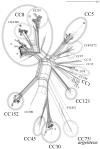Population structure of Staphylococcus aureus from Trinidad & Tobago
- PMID: 24586536
- PMCID: PMC3929661
- DOI: 10.1371/journal.pone.0089120
Population structure of Staphylococcus aureus from Trinidad & Tobago
Abstract
It has been shown previously that high rates of methicillin- and mupirocin-resistant Staphylococcus aureus exist in the Caribbean islands of Trinidad and Tobago, as well as a high prevalence of Panton-Valentine leukocidin-positive S. aureus. Beyond these studies, limited typing data have been published. In order to obtain insight into the population structure not only of MRSA but also of methicillin-susceptible S. aureus, 294 clinical isolates collected in 2012/2013 were typed by microarray hybridisation. A total of 15.31% of the tested isolates were MRSA and 50.00% were PVL-positive. The most common MSSA strains were PVL-positive CC8-MSSA (20.41% of all isolates tested), PVL-positive CC152-MSSA (9.52%) and PVL-positive CC30-MSSA (8.84%) while the most common MRSA were ST239-MRSA-III&SCCmer (9.18%) and ST8-MRSA-IV, "USA300" (5.78%). 2.38% of characterised isolates belonged to distinct strains likely to be related to "Staphylococcus argenteus" lineages. The population structure of S. aureus isolates suggests an importation of strains from Africa, endemicity of PVL-positive MSSA (mainly CC8) and of ST239-MRSA-III, and a recent emergence of the PVL-positive CC8-MRSA-IV strain "USA300".
Conflict of interest statement
Figures
Similar articles
-
Panton-Valentine leukocidin-positive Staphylococcus aureus in Ireland from 2002 to 2011: 21 clones, frequent importation of clones, temporal shifts of predominant methicillin-resistant S. aureus clones, and increasing multiresistance.J Clin Microbiol. 2014 Mar;52(3):859-70. doi: 10.1128/JCM.02799-13. Epub 2013 Dec 26. J Clin Microbiol. 2014. PMID: 24371244 Free PMC article.
-
Molecular characterization of antimicrobial resistance genes against Staphylococcus aureus isolates from Trinidad and Tobago.J Infect Public Health. 2017 May-Jun;10(3):316-323. doi: 10.1016/j.jiph.2016.05.010. Epub 2016 Jun 18. J Infect Public Health. 2017. PMID: 27328777
-
Population structure of Staphylococcus aureus strains isolated from intensive care unit patients in the netherlands over an 11-year period (1996 to 2006).J Clin Microbiol. 2009 Dec;47(12):4090-5. doi: 10.1128/JCM.00820-09. Epub 2009 Oct 7. J Clin Microbiol. 2009. PMID: 19812275 Free PMC article.
-
Staphylococcus aureus clones causing osteomyelitis: a literature review (2000-2020).J Glob Antimicrob Resist. 2021 Sep;26:29-36. doi: 10.1016/j.jgar.2021.03.030. Epub 2021 May 6. J Glob Antimicrob Resist. 2021. PMID: 33965630 Review.
-
Implications of identifying the recently defined members of the Staphylococcus aureus complex S. argenteus and S. schweitzeri: a position paper of members of the ESCMID Study Group for Staphylococci and Staphylococcal Diseases (ESGS).Clin Microbiol Infect. 2019 Sep;25(9):1064-1070. doi: 10.1016/j.cmi.2019.02.028. Epub 2019 Mar 11. Clin Microbiol Infect. 2019. PMID: 30872103 Review.
Cited by
-
Molecular epidemiology of Staphylococcus aureus from Lambaréné, Gabon.Eur J Clin Microbiol Infect Dis. 2016 Dec;35(12):1963-1973. doi: 10.1007/s10096-016-2748-z. Epub 2016 Aug 23. Eur J Clin Microbiol Infect Dis. 2016. PMID: 27553495
-
Clinical and molecular epidemiology of Staphylococcus argenteus infections in Thailand.J Clin Microbiol. 2015 Mar;53(3):1005-8. doi: 10.1128/JCM.03049-14. Epub 2015 Jan 7. J Clin Microbiol. 2015. PMID: 25568440 Free PMC article.
-
Clinical Staphylococcus argenteus Develops to Small Colony Variants to Promote Persistent Infection.Front Microbiol. 2018 Jun 27;9:1347. doi: 10.3389/fmicb.2018.01347. eCollection 2018. Front Microbiol. 2018. PMID: 30013523 Free PMC article.
-
Molecular Typing of ST239-MRSA-III From Diverse Geographic Locations and the Evolution of the SCCmec III Element During Its Intercontinental Spread.Front Microbiol. 2018 Jul 6;9:1436. doi: 10.3389/fmicb.2018.01436. eCollection 2018. Front Microbiol. 2018. PMID: 30087657 Free PMC article.
-
Evolutionary Divergence of the Novel Staphylococcal Species Staphylococcus argenteus.Front Microbiol. 2021 Nov 19;12:769642. doi: 10.3389/fmicb.2021.769642. eCollection 2021. Front Microbiol. 2021. PMID: 34867903 Free PMC article.
References
-
- Akpaka PE, Kissoon S, Rutherford C, Swanston WH, Jayaratne P (2007) Molecular epidemiology of methicillin-resistant Staphylococcus aureus isolates from regional hospitals in Trinidad and Tobago. Int J Infect Dis 11: 544–548. - PubMed
-
- Monecke S, Nitschke H, Slickers P, Ehricht R, Swanston W, et al. (2012) Molecular epidemiology and characterisation of MRSA isolates from Trinidad and Tobago. Eur J Clin Microbiol Infect Dis 31: 1497–1500. - PubMed
-
- Swanston WH (1999) Methicillin resistant Staphylococcus aureus . West Indian Med J 48: 20–22. - PubMed
MeSH terms
Substances
LinkOut - more resources
Full Text Sources
Other Literature Sources
Medical


